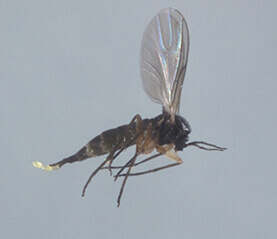
Fungus gnats can seem to appear out of nowhere. If you’re asking how are gnats born, it’s really just nature. Not magic. It may seem like magic when your home or business is insect-free one moment, and then dozens of tiny flies show up without any warning. To keep infestations at bay, you’ll need to identify the insects, learn why they get indoors, and find out how to get rid of gnats.
What are Gnats?
A fungus gnat is a small brown or black insect with a single pair of wings and antennae. Due to their long, thin legs, people sometimes mistake them for mosquitoes. However, these insects aren’t that great at flying. You’re much more likely to see them resting or crawling around near potted plants or landscaping.
Where are Gnats Coming from?
Fungus gnats lay their eggs in moist organic material like compost, mulch, and dirt. After hatching, the larvae consume decaying matter, fungi, and algae in the soil. After about two weeks of feeding, they pupate and emerge as mature flying pests. Although the adults are nuisances, their offspring can damage plant roots, which may cause foliage to wither and die.
These tiny flies quickly become a big issue in wet, humid locations like greenhouses or mushroom farms. The pests even cause trouble in hotel lobbies and offices when fungus gnats come from the soil of decorative potted plants. Bags of growing media or wood chips brought home from garden centers or nurseries also bring them indoors.
What Attracts Gnats?
Good breeding spots and ample food supplies appeal to the pests. Rotting leaves, damp mulch in flowerbeds, and light attract gnats, too. Open doors and damaged screens near landscaping or brightly lit signs above hotel and grocery store entrances make it easy for the flies to move indoors.
How to Get Rid of Gnats
Now that we know how do gnats form, the best way to solve a fungus gnat problem is to remove any conditions where they can thrive. Simple actions like avoiding overwatering and clearing out dead foliage in plant containers go a long way toward removing these flies. Florists and nursery employees need to be vigilant to get rid of gnats, so customers don’t purchase infested products.
Prevent excess moisture in homes and businesses by fixing plumbing leaks and carefully cleaning up any water left behind. Wring out mops thoroughly, so they don’t attract gnats. Outdoors, keep landscape bedding under three inches thick, so it can dry out properly after rainfall.
There are many homemade and commercial traps available to deal with minor fungus gnat issues. When dealing with more serious infestations, contact the experienced professionals at Western Pest Services for help.